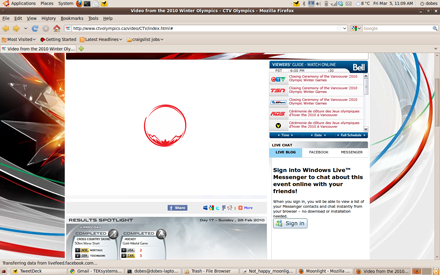Moonlight's Olympic-sized failure

If there's a jewel in the crown of Silverlight, it has to be video coverage of the Olympics.
Every couple of years, Microsoft and its partners get to show off what the technology is capable of and push the limits of live video coverage. This year, the plethora of Canadian channels covering the Olympics were all available live from one website, and the experience was terrific.
Thanks to a sometimes flaky wireless connection, I was ever thankful for Silverlight's adaptive streaming; and most impressively, the Tivo-like ability to watch live, rewind to a missed moment, and return to live coverage at the click of a button. Another great feature was the archiving and marking of events, meaning that a viewer could go to a video and easily find the medal winning performances.
Unless you were using Linux that is.
As history shows, Microsoft only produces the Silverlight runtime for Windows and OS X, leaving Linux support to Novell's Mono project, which produces Moonlight. Mono developers argue that Mono is not chasing tail lights, but in the case of Moonlight it very clearly is.
The Olympics player made use of Silverlight 3.0, which was available from mid-2009. Moonlight on the other hand is only stable up to Silverlight 2 (first released in late 2008) and only offers Silverlight 3 support as a 3.0 preview release.
Moonlight 2 users were prompted to install the 3.0 preview release when attempting to view a stream, but all was not well. With the initial 3.0 preview, sometimes the player would appear, and sometimes not. And when it did appear, all that occurred was the spinning of a loading icon (see screenshot below).

Trying to view an Olympics stream using Moonlight
(Screenshot by Chris Duckett)
It took until four days later, on the second update to the 3.0 preview, for Moonlight users to be able to stream video correctly — except now the volume and full-screen buttons rendered off-screen. Of course by that time, I had written off using Moonlight, and had settled into watching the Olympics courtesy of Windows or OS X.
There were other such failures throughout the site that resulted in an overall very frustrating experience and not one to recommend at all. In comparison, watching the opening and closing ceremonies in HD on an iMac was far better than watching it via the analog TV option.
With all these problems, it is clear that Moonlight is not up to scratch; thank goodness Flash videos have less Linux issues and HTML5 video is (hopefully) coming. For a company that has $991 million in cash (PDF), I'd have hoped that Novell would back Moonlight to have it ready in time for the Olympics showcase, but alas.
To rub more timely salt into the wounds, Chrome support for Moonlight appeared on Friday — better late than never.